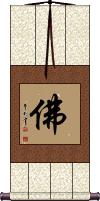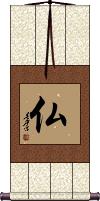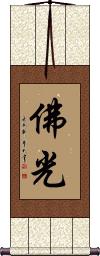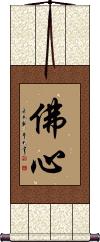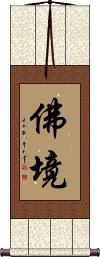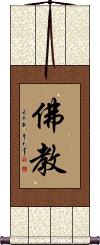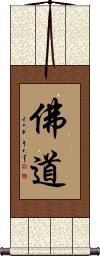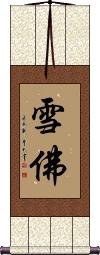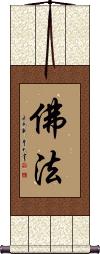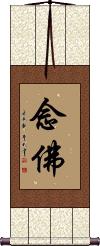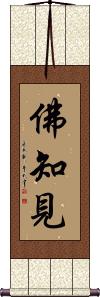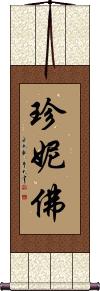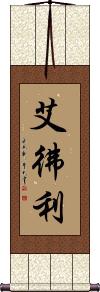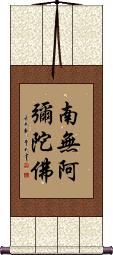Many custom options...
And formats...

佛 in Chinese / Japanese...
Buy an 佛 calligraphy wall scroll here!
Personalize your custom “佛” project by clicking the button next to your favorite “佛” title below...
4. Buddha Heart / Mind of Buddha
5. The Buddha Realm / Buddhahood
6. Buddhism
7. Buddha Way
9. Chevy
10. Denver
11. Dharma / Buddhist Doctrine
12. Mantra to Buddha / Nembutsu
13. Wisdom and Insight of the Buddha
15. Faudel
16. Franco
17. Ginnifer
18. Ivory
19. Jeffrey
20. Vercammen
22. Happy Buddha
23. Seeing one’s Nature and becoming a Buddha
24. Amitabha Buddha
25. Firenze
26. Florence
27. Florida
28. Forest
29. Foster
30. Kensho Jobutsu - Enlightenment - Path to Buddha
31. Persefoni
32. Yvonette
33. Branford
34. Five Families / Tsoi Li Hoi Fut Hung
35. Fortunata
36. Wilfredo
39. The Buddha is in Each Sentient Being
40. Meet the Buddha, Kill the Buddha
41. Self Awareness Becomes a Buddha
42. Heart Sutra
Buddhism / Buddha
佛 is the essence of the Buddha or Buddhism.
Depending on the context, this word and character can be used to refer to the religion and lifestyle of Buddhism, or in some cases, the Buddha himself.
It is interesting to note that this word is separate from all others in the Chinese language. The sound of “fo” has only this meaning. 佛 is in contrast to many sounds in the Chinese language, which can have one of four tones, and more than 20 possible characters and meanings. This language anomaly shows how significantly Buddhism has affected China since ancient times.
More about Buddhism
佛 is also used with the same meaning in Korean Hanja.
It's used in the very religious context of Buddhism in Japan. It should be noted that there are two forms of this Kanji in use in Japan - this is the more formal/ancient version, but it's rarely seen outside of religious artwork and may not be recognized by all Japanese people.
It also acts as a suffix or first syllable for many Buddhist-related words in Chinese, Japanese, and Korean.
See our Buddhism & Zen page
Buddha / Buddhism
Hotoke
仏 is the single Japanese Kanji that can mean Buddha or Buddhism.
This Kanji was a shorthand way to write 佛 (Buddha) in Chinese (popular around the 13th century). Somehow, this became the version of this Chinese character that was absorbed into Japanese and thus became part of standard Kanji. Centuries later, this character is not recognized in China (except for those from China with a background in Chinese literature or language).
仏 is also a rare or derivative Korean Hanja form - but I doubt you will find any Korean that knows that.
The Aura of Buddha
Buddha Heart / Mind of Buddha
佛心 means the Buddha's mind, Buddha-heart, or the spiritually enlightened heart/mind.
The Buddha Heart is detached from good and evil and other such constructs. The Buddha Heart has mercy, compassion, and loving-kindness for all sentient life, the good, the wicked, and all in between.
The heart and mind (心) are the same concepts in the ancient Orient, so you can use heart and mind interchangeably in this context.
The Buddha Realm / Buddhahood
Buddhism
(2 characters)
佛教 is the more exact way to express the religion or lifestyle of Buddhism.
It can also be read as “Buddha's Teachings.” 佛教 is Chinese only, as a different character is more commonly used in Japanese to express Buddhism. The same first character is used in Korea, but a slight variation exists in the second character in Korean Hanja. However, it would be fully recognized by any Korean person who can read Hanja.
Buddha Way
佛道 is “The way of Buddha, leading to Buddhahood” or the way to becoming a bodhi and enlightened.
Known in Japanese as Butsudō, in Mandarin Chinese as Fódào, and in Korean as Buldo or 불도.
The Principles of Buddhism
In short, 佛義 is the Principles of Buddhism, but there is more (especially for the second character):
佛 is the character for the Buddha and Buddhism.
義 has deeper meanings including justice, righteousness, morality, honour/honor, teachings, doctrine, right, proper, righteous, loyalty, purpose, or meaning. So the single word “principles” is often used to encompass all these ideas.
Chevy
Denver
Dharma / Buddhist Doctrine
Mantra to Buddha / Nembutsu
念佛 is used primarily in Japanese, where it is romanized as nenbutsu.
The meaning is to pray to Buddha, chant the name of Buddha, or repeat the name of Buddha. This can be an audible or inaudible chant.
Wisdom and Insight of the Buddha
Buddha Dharma Sangha
Faudel
Franco
Ginnifer
Ivory
Jeffrey
Vercammen
The Eye of the Buddha
Happy Buddha
Buddha of Joyful Light
Seeing one’s Nature and becoming a Buddha
見性成佛 is a universal phrase that suggests that one may see one's nature and accomplish Buddhahood.
見性 suggests penetrating deep inside oneself to see one's “Original finally
Mind.”
成佛 refers to a sentient being who dispenses with illusions and delusions
through ascetic practice, is enlightened to the truth, and becomes a Buddha.
This is used by Mahayana, Chan, and Zen Buddhists in China, Korea, and Japan.
You will also see this with the last character written as 仏 in Japanese. In the religious context, 佛 is commonly used to mean Buddha. If you want the other version, see Kenshō Jōbutsu 見性成仏
Amitabha Buddha
This title can mean the Buddha of the Western paradise.
But it's more a chant that means “May the lord Buddha preserve us!” or “Merciful Buddha!.”
阿彌陀佛 is also a translation to Chinese, Japanese, and Korean for “Amitâbha Buddha.”
Asian Buddhists will often greet and say goodbye to each other with this phrase/chant/title.
Firenze
Florence
Florida
Forest
Given Name
Foster
Kensho Jobutsu - Enlightenment - Path to Buddha
Persefoni
Yvonette
Branford
Five Families / Tsoi Li Hoi Fut Hung
蔡李何佛雄 is the five families associated with San Soo Kung Fu.
The characters are always the same, but there are several ways these are romanized from Cantonese, Mandarin, and other dialects. Some common ones include Tsoi Li Hoi Fut Hung and Choi Li Ho Fut Hung.
If you are using a different romanization, that does not mean it's wrong. It might just be that your school is using a different dialect or romanization scheme.
Fortunata
Wilfredo
Namo Amitabha Buddha
南無阿彌陀佛 is how to express “The Compassionate Amitabha Buddha” (especially for the Pure Land Buddhist Sect).
Some will translate as “Homage to Amitâbha Buddha” or “I seek refuge in the Amitâbha Buddha.”
This is valid in Chinese characters, Japanese Kanji, and old Korean Hanja.
Sometimes modern Japanese use a different version of the 4th and last Kanji, but the version shown here is the most universal.
This is used to pay homage to Amitabha Buddha.
Namo Shakyamuni Buddha
南無釋迦牟尼佛 is a Buddhist chant or prayer of respect to the Shakyamuni Buddha.
Some will translate this as the Buddhist vow.
The first two characters, 南無, are sometimes translated as “amen”; others will translate it as “belief in” or “homage to.”
To expand on this, 南無 can also mean “taking of refuge in” while representing devotion or conviction. 南無 as with most religious concepts or words, different people or denominations will have varying definitions.
The Buddha is in Each Sentient Being
佛は衆生の中に在り is “Butsu wa shujo no naka ni ari” and means that the Buddha (potential for Buddhahood) exists in all beings in the universe.
So yes, your dog has the potential to be a Buddha (but only in a future reincarnation as a human). But all things, from the tiny cricket to the humpback whale have Buddha nature within them. If one takes the time to look and contemplate, one will see the Buddha in all things.
In Japan, sometimes the Buddha character is written 仏 instead of 佛, so you might see the whole phrase written as 仏は衆生の中に在り.
Note: Because this selection contains some special Japanese Hiragana characters, it should be written by a Japanese calligrapher.
Meet the Buddha, Kill the Buddha
This controversial Buddhist koan means “On encountering Buddha, you should kill him.”
This is the short concise Japanese version of an original statement by ninth-century Chinese Buddhist monk Linji Yixuan, “If You Meet The Buddha On The Road, Kill Him.”
This takes some explaining... The concept here is that if you think you have seen, experienced, or achieved true enlightenment, the chances that you really have are so slim that you should kill or dismiss that idea.
Another suggestion is that one's path to becoming a Buddha is one's own, and one should not get caught up in religious fervor, and avoid “showing off” that they are a Buddhist.
Helpful references for this concept:
Lion's Roar addresses "If You Meet The Buddha On The Road, Kill Him"
Kill the Buddha
Note: Because this selection contains some special Japanese Hiragana characters, it should be written by a Japanese calligrapher.
Self Awareness Becomes a Buddha
自性覚れば即ち是れ佛なり is a Zen quote that means “If one realizes one's own nature, one becomes a Buddha.”
The inference here is that if you understand who you really are, and become truly aware of yourself and your original nature, you are well on your way to becoming a liberated person (a Buddha).
Note: Because this selection contains some special Japanese Hiragana characters, it should be written by a Japanese calligrapher.
Heart Sutra
This is the Heart Sutra in Chinese as translated by Xuanzang.
The Heart Sutra is often cited as the best-known and most popular of all Buddhist scriptures.
Notes: There are too many characters for this to be done by the economy calligrapher. You must choose a Master Calligrapher.
With this many characters, and the fact that one tiny mistake wipes out hours of work, keep in mind that writing the Heart Sutra is usually a full day of work for a calligrapher. This work and personal energy should be cherished and respected. In other words, the calligrapher is not charging enough money for the value that you are getting here.
Also, you will find that as my server processes 260 characters, the customization process is a bit slow for this title.
Not the results for 佛 that you were looking for?
Below are some entries from our dictionary that may match your 佛 search...
| Characters If shown, 2nd row is Simp. Chinese |
Pronunciation Romanization |
Simple Dictionary Definition |
佛 see styles |
fó fo2 fo hotoke ほとけ |
More info & calligraphy: Buddhism / Buddha(surname) Hotoke Buddha, from budh to "be aware of", "conceive", "observe", "wake"; also 佛陀; 浮圖; 浮陀; 浮頭; 浮塔; 勃陀; 勃馱; 沒馱; 母馱; 母陀; 部陀; 休屠. Buddha means "completely conscious, enlightened", and came to mean the enlightener. he Chinese translation is 覺 to perceive, aware, awake; and 智 gnosis, knowledge. There is an Eternal Buddha, see e.g. the Lotus Sutra, cap. 16, and multitudes of Buddhas, but the personality of a Supreme Buddha, an Ādi-Buddha, is not defined. Buddha is in and through all things, and some schools are definitely Pan-Buddhist in the pantheistic sense. In the triratna 三寳 commonly known as 三寳佛, while Śākyamuni Buddha is the first "person" of the Trinity, his Law the second, and the Order the third, all three by some are accounted as manifestations of the All-Buddha. As Śākyamuni, the title indicates him as the last of the line of Buddhas who have appeared in this world, Maitreya is to be the next. As such he is the one who has achieved enlightenment, having discovered the essential evil of existence (some say mundane existence, others all existence), and the way of deliverance from the constant round of reincarnations; this way is through the moral life into nirvana, by means of self-abnegation, the monastic life, and meditation. By this method a Buddha, or enlightened one, himself obtains Supreme Enlightenment, or Omniscience, and according to Māhāyanism leads all beings into the same enlightenment. He sees things not as they seem in their phenomenal but in their noumenal aspects, as they really are. The term is also applied to those who understand the chain of causality (twelve nidānas) and have attained enlightenment surpassing that of the arhat. Four types of the Buddha are referred to: (1) 三藏佛the Buddha of the Tripiṭaka who attained enlightenment on the bare ground under the bodhi-tree; (2) 通佛the Buddha on the deva robe under the bodhi-tree of the seven precious things; (3) 別佛the Buddha on the great precious Lotus throne under the Lotus realm bodhi-tree; and (4) 圓佛the Buddha on the throne of Space in the realm of eternal rest and glory where he is Vairocana. The Hīnayāna only admits the existence of one Buddha at a time; Mahāyāna claims the existence of many Buddhas at one and the same time, as many Buddhas as there are Buddha-universes, which are infinite in number. |
丹佛 see styles |
dān fó dan1 fo2 tan fo |
More info & calligraphy: Denver |
佛光 see styles |
fó guāng fo2 guang1 fo kuang bukkō |
More info & calligraphy: The Aura of BuddhaThe light of Buddha, spiritual enlightenment; halo, glory. |
佛境 see styles |
fó jìng fo2 jing4 fo ching bukkyō |
More info & calligraphy: The Buddha Realm / Buddhahood |
佛心 see styles |
fó xīn fo2 xin1 fo hsin busshin |
More info & calligraphy: Buddha Heart / Mind of BuddhaThe mind of Buddha, the spiritually enlightened heart. A heart of mercy; a heart abiding in the real, not the seeming; detached from good and evil and other such contrasts. |
佛教 see styles |
fó jiào fo2 jiao4 fo chiao bukkyō ぶっきょう |
More info & calligraphy: Buddhism(out-dated kanji) Buddhism Buddha's teaching; Buddhism, v. 釋教. |
佛法 see styles |
fó fǎ fo2 fa3 fo fa buppō |
More info & calligraphy: Dharma / Buddhist Doctrinebuddhadharma; the Dharma or Law preached by the Buddha, the principles underlying these teachings, the truth attained by him, its embodiment in his being. Buddhism. |
佛眼 see styles |
fó yǎn fo2 yan3 fo yen butsugen |
More info & calligraphy: The Eye of the Buddha |
佛義 佛义 see styles |
fó yì fo2 yi4 fo i butsugi |
More info & calligraphy: The Principles of Buddhism |
佛道 see styles |
fó dào fo2 dao4 fo tao butsudō |
More info & calligraphy: Buddha Way |
念佛 see styles |
niàn fó nian4 fo2 nien fo nenbutsu |
More info & calligraphy: Mantra to Buddha / NembutsuTo repeat the name of a Buddha, audibly or inaudibly. |
佛朗哥 see styles |
fó lǎng gē fo2 lang3 ge1 fo lang ko |
More info & calligraphy: Franco |
佛法僧 see styles |
fó fǎ sēng fo2 fa3 seng1 fo fa seng buppō sō |
More info & calligraphy: Buddha Dharma Sangha |
佛知見 佛知见 see styles |
fó zhī jiàn fo2 zhi1 jian4 fo chih chien bucchiken |
More info & calligraphy: Wisdom and Insight of the Buddha |
佛羅倫薩 佛罗伦萨 see styles |
fó luó lún sà fo2 luo2 lun2 sa4 fo lo lun sa |
More info & calligraphy: Firenze |
佛羅里達 佛罗里达 see styles |
fú luó lǐ dá fu2 luo2 li3 da2 fu lo li ta |
More info & calligraphy: Florida |
歡喜光佛 欢喜光佛 see styles |
huān xǐ guāng fó huan1 xi3 guang1 fo2 huan hsi kuang fo Kangi Kōbutsu |
More info & calligraphy: Happy Buddha |
見性成佛 见性成佛 see styles |
jiàn xìng chéng fó jian4 xing4 cheng2 fo2 chien hsing ch`eng fo chien hsing cheng fo kenshō jōbutsu |
More info & calligraphy: Seeing one’s Nature and becoming a Buddha |
阿弥陀佛 see styles |
amidabutsu あみだぶつ |
More info & calligraphy: Amitabha Buddha |
阿彌陀佛 阿弥陀佛 see styles |
ē mí tuó fó e1 mi2 tuo2 fo2 o mi t`o fo o mi to fo Amida butsu |
More info & calligraphy: Amitabha BuddhaAmitâbha Buddha |
南無阿彌陀佛 南无阿弥陀佛 see styles |
nán wú ā mí tuó fó nan2 wu2 a1 mi2 tuo2 fo2 nan wu a mi t`o fo nan wu a mi to fo namo amida butsu |
More info & calligraphy: Namo Amitabha Buddha |
彿 佛 see styles |
fú fu2 fu |
seemingly See: 佛 |
髴 佛 see styles |
fú fu2 fu |
(female) head ornament; variant of 彿|佛[fu2] See: 佛 |
一佛 see styles |
yī fó yi1 fo2 i fo ichibutsu いちぶつ |
(surname) Ichibutsu one buddha |
七佛 see styles |
qī fó qi1 fo2 ch`i fo chi fo shichibutsu |
sapta Buddha. The seven ancient Buddhas, viz. Vipaśyin 毘婆尸, Śikhin 尸棄, Viśvabhū 毘舍婆, Krakucchanda 拘樓孫, Kanakamuni 倶那含牟尼 or 拘那含, Kāśyapa 迦葉, and Śākyamuni 釋迦. The last four are said to be of the present kalpa. |
三佛 see styles |
sān fó san1 fo2 san fo sanbutsu さんぶつ |
(surname) Sanbutsu Trikāya, v. 三身. Also the三岐 or founders of the 楊岐 branch of the Chan (Zen) School, i.e. Huiqin 慧勤, Qingyuan 淸遠, and Keqin 克勤. |
下佛 see styles |
shimobutsu しもぶつ |
(surname) Shimobutsu |
久佛 see styles |
kyuubutsu / kyubutsu きゅうぶつ |
(surname) Kyūbutsu |
事佛 see styles |
shì fó shi4 fo2 shih fo jibutsu |
serve the Buddha |
二佛 see styles |
èr fó er4 fo2 erh fo nibutsu |
two buddhas |
Click here for more 佛 results from our dictionary
The following table may be helpful for those studying Chinese or Japanese...
| Title | Characters | Romaji (Romanized Japanese) | Various forms of Romanized Chinese | |
| Buddhism Buddha | 佛 | hotoke | fó / fo2 / fo | |
| Buddha Buddhism | 佛 仏 | hotoke / butsu | ||
| The Aura of Buddha | 佛光 | bukkou / buko | fó guāng / fo2 guang1 / fo guang / foguang | fo kuang / fokuang |
| Buddha Heart Mind of Buddha | 佛心 | busshin / bushin | fó xīn / fo2 xin1 / fo xin / foxin | fo hsin / fohsin |
| The Buddha Realm Buddhahood | 佛境 | bukkyou / bukyo | fó jìng / fo2 jing4 / fo jing / fojing | fo ching / foching |
| Buddhism | 佛教 | fó jiào / fo2 jiao4 / fo jiao / fojiao | fo chiao / fochiao | |
| Buddha Way | 佛道 | butsudō | fó dào / fo2 dao4 / fo dao / fodao | fo tao / fotao |
| The Principles of Buddhism | 佛義 佛义 | butsu gi / butsugi | fó yì / fo2 yi4 / fo yi / foyi | fo i / foi |
| Chevy | 雪佛 | xuě fú / xue3 fo2 / xue fo / xuefo | hsüeh fo / hsüehfo | |
| Denver | 丹佛 | dān fó / dan1 fo2 / dan fo / danfo | tan fo / tanfo | |
| Dharma Buddhist Doctrine | 佛法 | fó fǎ / fo2 fa3 / fo fa / fofa | ||
| Mantra to Buddha Nembutsu | 念佛 | nenbutsu | niàn fó / nian4 fo2 / nian fo / nianfo | nien fo / nienfo |
| Wisdom and Insight of the Buddha | 佛知見 佛知见 | bucchiken / buchiken | fó zhī jiàn fo2 zhi1 jian4 fo zhi jian fozhijian | fo chih chien fochihchien |
| Buddha Dharma Sangha | 佛法僧 | buppō sō / buppōsō / bupō sō | fó fǎ sēng fo2 fa3 seng1 fo fa seng fofaseng | |
| Faudel | 佛德爾 佛德尔 | fó dé ěr fo2 de2 er3 fo de er fodeer | fo te erh foteerh |
|
| Franco | 佛朗哥 | fú lǎng gē fo2 lang3 ge1 fo lang ge folangge | fo lang ko folangko |
|
| Ginnifer | 珍妮佛 | zhēn nī fú zhen1 ni1 fo2 zhen ni fo zhennifo | chen ni fo chennifo |
|
| Ivory | 艾彿利 艾佛利 | ài fó lì ai4 fo2 li4 ai fo li aifoli | ||
| Jeffrey | 杰佛瑞 | jié fó ruì jie2 fo2 rui4 jie fo rui jieforui | chieh fo jui chiehfojui |
|
| Vercammen | 佛卡門 佛卡门 | fó kǎ mén fo2 ka3 men2 fo ka men fokamen | fo k`a men fokamen fo ka men |
|
| The Eye of the Buddha | 佛眼 佛眼 / 仏眼 | butsugen / butsugen | wǔ yǎn / wu3 yan3 / wu yan / wuyan | wu yen / wuyen |
| Happy Buddha | 歡喜光佛 欢喜光佛 | kan gi kou butsu kangikoubutsu kan gi ko butsu | huān xǐ guāng fó huan1 xi3 guang1 fo2 huan xi guang fo huanxiguangfo | huan hsi kuang fo huanhsikuangfo |
| Seeing one’s Nature and becoming a Buddha | 見性成佛 见性成佛 | ken shou jou butsu kenshoujoubutsu ken sho jo butsu | jiàn xìng chéng fó jian4 xing4 cheng2 fo2 jian xing cheng fo jianxingchengfo | chien hsing ch`eng fo chienhsingchengfo chien hsing cheng fo |
| Amitabha Buddha | 阿彌陀佛 阿弥陀佛 | amida butsu amidabutsu | ē mí tuó fó e1 mi2 tuo2 fo2 e mi tuo fo emituofo | o mi t`o fo omitofo o mi to fo |
| Firenze | 佛羅倫薩 佛罗伦萨 | fó luó lún sà fo2 luo2 lun2 sa4 fo luo lun sa foluolunsa | fo lo lun sa fololunsa |
|
| Florence | 佛羅倫薩 佛罗伦萨 | fó luó lún sà fo2 luo2 lun2 sa4 fo luo lun sa foluolunsa | fo lo lun sa fololunsa |
|
| Florida | 佛羅里達 佛罗里达 | fó luó lǐ dá fo2 luo2 li3 da2 fo luo li da foluolida | fo lo li ta fololita |
|
| Forest | 佛雷斯特 | fó léi sī tè fo2 lei2 si1 te4 fo lei si te foleisite | fo lei ssu t`e foleissute fo lei ssu te |
|
| Foster | 佛史特爾 佛史特尔 | Fó shǐ tè ěr Fo2 shi3 te4 er3 Fo shi te er Foshiteer | Fo shih t`e erh Foshihteerh Fo shih te erh |
|
| Kensho Jobutsu - Enlightenment - Path to Buddha | 見性成佛 見性成仏 | ken shou jou butsu kenshoujoubutsu ken sho jo butsu | ||
| Persefoni | 佩色佛妮 | pèi sè fó nī pei4 se4 fo2 ni1 pei se fo ni peisefoni | p`ei se fo ni peisefoni pei se fo ni |
|
| Yvonette | 伊佛內特 伊佛内特 | yī fó nèi tè yi1 fo2 nei4 te4 yi fo nei te yifoneite | i fo nei t`e ifoneite i fo nei te |
|
| Branford | 布蘭佛爾德 布兰佛尔德 | bù lán fó ěr dé bu4 lan2 fo2 er3 de2 bu lan fo er de bulanfoerde | pu lan fo erh te pulanfoerhte |
|
| Five Families Tsoi Li Hoi Fut Hung | 蔡李何佛雄 | cài lǐ hé fú xióng cai4 li3 he2 fu2 xiong2 cai li he fu xiong cailihefuxiong | ts`ai li ho fu hsiung tsailihofuhsiung tsai li ho fu hsiung |
|
| Fortunata | 佛爾圖娜塔 佛尔图娜塔 | fó ěr tú nà tǎ fo2 er3 tu2 na4 ta3 fo er tu na ta foertunata | fo erh t`u na t`a foerhtunata fo erh tu na ta |
|
| Wilfredo | 威爾彿瑞多 威尔佛瑞多 | wēi ěr fó ruì duō wei1 er3 fo2 rui4 duo1 wei er fo rui duo weierforuiduo | wei erh fo jui to weierhfojuito |
|
| Namo Amitabha Buddha | 南無阿彌陀佛 南无阿弥陀佛 | na mu a mi da butsu namuamidabutsu | nā mó ē mí tuó fó na1 mo2 e1 mi2 tuo2 fo2 na mo e mi tuo fo namoemituofo | na mo o mi t`o fo namoomitofo na mo o mi to fo |
| Namo Shakyamuni Buddha | 南無釋迦牟尼佛 南无释迦牟尼佛 | namu shakamuni butsu namushakamunibutsu | nán wú shì jiā móu ní fó nan2 wu2 shi4 jia1 mou2 ni2 fo2 nan wu shi jia mou ni fo nanwushijiamounifo | nan wu shih chia mou ni fo nanwushihchiamounifo |
| The Buddha is in Each Sentient Being | 佛は衆生の中に在り | butsu wa shujou no naka ni ari butsuwashujounonakaniari butsu wa shujo no naka ni ari | ||
| Meet the Buddha, Kill the Buddha | 佛に逢っては佛を殺す | butsu ni atte wa butsu o korosu | ||
| Self Awareness Becomes a Buddha | 自性覚れば即ち是れ佛なり | Jishou satore ba sunawachi kore butsu nari Jisho satore ba sunawachi kore butsu nari | ||
| Heart Sutra | 觀自在菩薩行深般若波羅蜜多時照見五蘊皆空度一切苦厄舍利子色不異空空不異色色即是空空即是色受想行識亦復如是舍利子是諸法空相不生不滅不垢不淨不增不減是故空中無色無受想行識無眼耳鼻舌身意無色聲香味觸法無眼界乃至無意識界無無明亦無無明盡乃至無老死亦無老死盡無苦集滅道無智亦無得以無所得故菩提薩埵依般若波羅蜜多故心無罣礙無罣礙故無有恐怖遠離顛倒夢想究竟涅盤三世諸佛依般若波羅蜜多故得阿耨多羅三藐三菩提故知般若波羅蜜多是大神咒是大明咒是無上咒是無等等咒能除一切苦真實不虛故說般若波羅蜜多咒即說咒曰揭諦揭諦波羅揭諦波羅僧揭諦菩提薩婆訶 观自在菩萨行深般若波罗蜜多时照见五蕴皆空度一切苦厄舍利子色不异空空不异色色即是空空即是色受想行识亦复如是舍利子是诸法空相不生不灭不垢不净不增不减是故空中无色无受想行识无眼耳鼻舌身意无色声香味触法无眼界乃至无意识界无无明亦无无明尽乃至无老死亦无老死尽无苦集滅道无智亦无得以无所得故菩提萨埵依般若波罗蜜多故心无罣碍无罣碍故无有恐怖远离颠倒梦想究竟涅盘三世诸佛依般若波罗蜜多故得阿耨多罗三藐三菩提故知般若波罗蜜多是大神咒是大明咒是无上咒是无等等咒能除一切苦真实不虚故说般若波罗蜜多咒即说咒曰揭谛揭谛波罗揭谛波罗僧揭谛菩提萨婆诃 | |||
| In some entries above you will see that characters have different versions above and below a line. In these cases, the characters above the line are Traditional Chinese, while the ones below are Simplified Chinese. | ||||
Successful Chinese Character and Japanese Kanji calligraphy searches within the last few hours...
